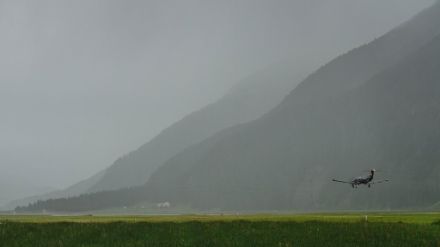Service Navigation
Search
The term “precipitation” includes rain, snow, hail, sleet and other, rarer forms of precipitation. Rain is measured in millimetres (mm). Precipitation of 1 mm is equal to one litre of water per square metre. With snowfall, 1 mm of water produces around 1 cm of snow on average.
Measuring precipitation
Precipitation is measured at the ground-level weather stations in the MeteoSwiss automatic monitoring network. The measurements are taken every 10 minutes with a pluviometer. The current precipitation totals and historical graphs can be found under Measurement values at meteorological stations. The monthly and annual precipitation amounts for the whole of Switzerland since 1981 can be found under Monthly and annual grid maps. Long-term averages are available under Climate normals in the form of maps or tables for each weather station.
Shower or rain?
Weather forecasts often contain the words “showers” or “snow showers”. Showers are brief and affect localised areas. Nevertheless, they can be very heavy. The terms “rain” and “snowfall” are used when the precipitation event is expected to last longer and affect a wider region. Thunderstorms often bring short-lived but heavy precipitation.

Extreme precipitation events can be brief (10 minutes) or last for a longer period (72 hours). The intensity, geographical distribution and effects of precipitation can vary.
Hazard warnings
When heavy precipitation is forecast, Level 2 to Level 5 hazard warnings of heavy rainfall or heavy snowfall are issued. The levels of the warnings vary based on the expected precipitation amounts, the duration of the event and the region. In terms of rain, the warning thresholds are higher for the regions on the southern side of the Alps, as heavy rainfall there on average lasts longer and is more intense than in other regions of Switzerland. Different warning thresholds are defined for different regions on the basis of the climatology of heavy precipitation and its geographical distribution. For snowfall, higher thresholds apply in the mountains, where it is a more frequent occurrence.
If a short burst of heavy precipitation is expected with a thunderstorm, then it is the severe thunderstorm warning that is issued to cover a wide area. Once a thunderstorm has formed, warnings are issued at very short notice for places in its path. These warnings also give information about the risk of hail. If warnings are issued for heavy rain, heavy snowfall or severe thunderstorms, it is important to follow the relevant recommendations for action.
Set phrases in the weather forecast
Various expressions are used in the weather forecast to describe the spatial distribution of precipitation.
| Term | Explanation |
| Local, localised | Occurs in a maximum of 40% of the affected region. |
| Regional | Occurs in 40–70% of the affected region. |
| Widespread (without specific detail) | Occurs in 70–100% of the affected region. |
Terms and explanations of spatial distribution of precipitation in the weather forecast. (© MeteoSwiss)
The intensity of precipitation can also vary, and is defined using the following terms:
| Term | Total per 24 hours in mm | Explanation |
| Low | 0.1–2 | Some rain, light rain, scattered showers A few drops, a few flakes Light snowfall, snow showers, drizzle |
| Medium | 2–10 | Some precipitation, some showers (with occasional thunder) |
| High | 10–30 | Heavy precipitation, heavy rain (with occasional thunder), occasional thunderstorms |
| Very high | 30–50 | Heavy precipitation, heavy rain |
| Profuse | >50 | Profuse precipitation/rainfall |
Terms and explanations of precipitation intensity in the weather forecast; 1 mm of rain generally corresponds to 1 cm of snow. (© MeteoSwiss)